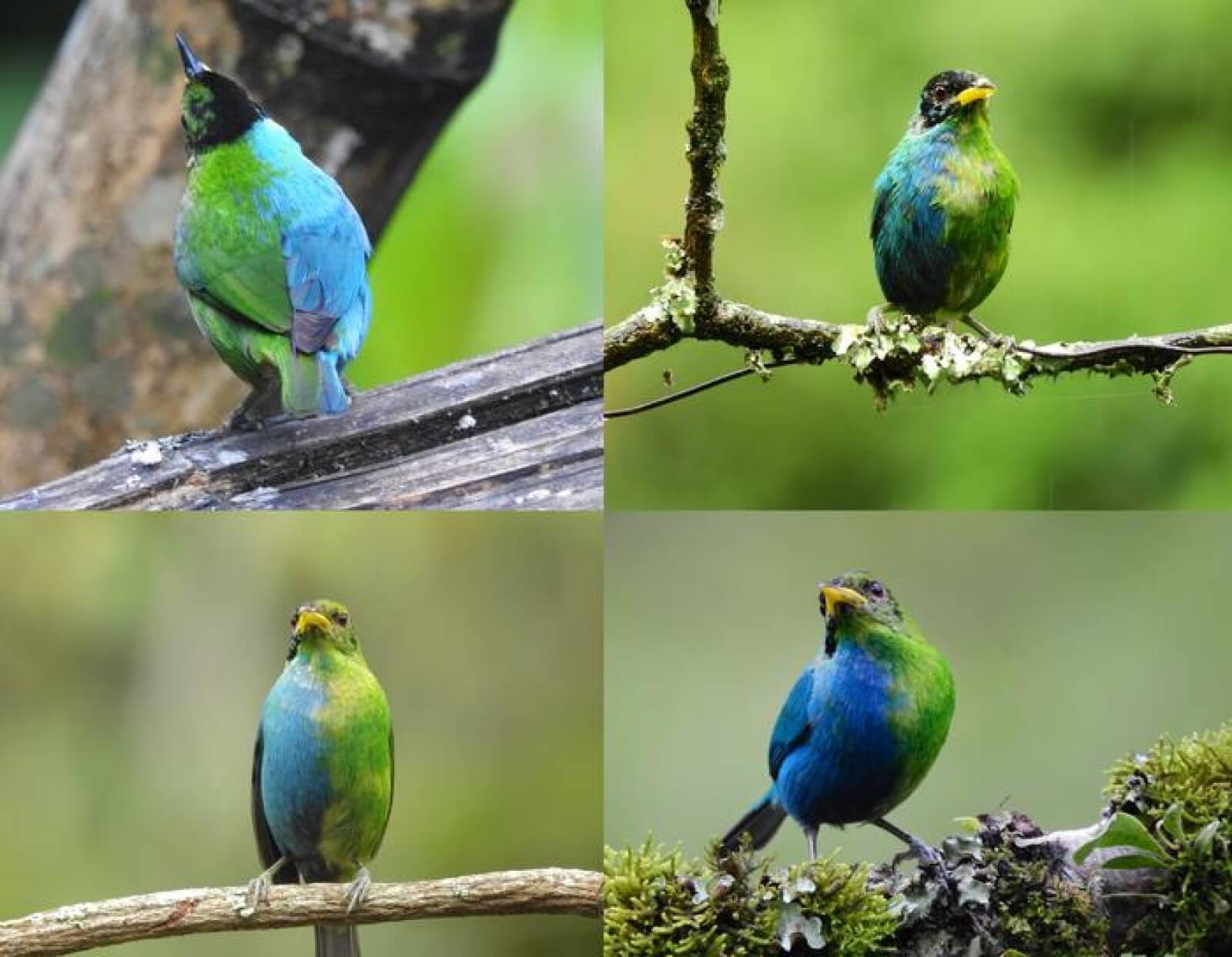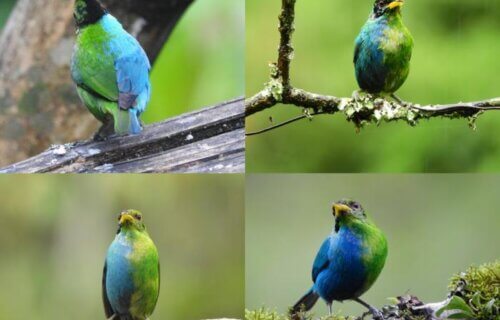DUNEDIN, New Zealand — In a remarkable discovery, a zoologist from the University of Otago has spotted an extremely rare bird displaying both male and female characteristics while vacationing in Colombia. This bird, a Green Honeycreeper, was pointed out to Sesquicentennial Distinguished Professor Hamish Spencer by an amateur ornithologist, John Murillo. The bird appears to have unique plumage, half green, which is typical of females, and half blue, characteristic of males.
“Many birdwatchers could go their whole lives and not see a bilateral gynandromorph in any species of bird. The phenomenon is extremely rare in birds, I know of no examples from New Zealand ever. It is very striking, I was very privileged to see it,” Prof. Spencer says in a university release.
The term “bilateral gynandromorph” refers to an organism that exhibits both male and female physical characteristics. In this case, the bird had an amazing split appearance, with one side clearly exhibiting female features and the other side displaying male feathers. This phenomenon is notably rare in birds.
What makes this discovery even more significant are the photographs taken of the bird, which Prof. Spencer describes as “arguably the best of a wild bilateral gynandromorphic bird of any species ever.” These photographs add substantial value to the scientific community, offering a detailed look at this rare occurrence in nature.

The discovery marks only the second recorded instance of gynandromorphism in this species in over a century. Gynandromorphism is a condition where an animal possesses both male and female characteristics in species that typically have separate sexes.
According to Prof. Spencer, such cases are vital for understanding sex determination and sexual behavior in birds. Gynandromorphism is more common among species with strong sexual dimorphism, meaning the males and females have distinctly different appearances. This phenomenon has been recorded in various animal groups, including insects (particularly butterflies), crustaceans, spiders, and even some lizards and rodents.
“This particular example of bilateral gynandromorphy – male one side and female the other – shows that, as in several other species, either side of the bird can be male or female. The phenomenon arises from an error during female cell division to produce an egg, followed by double-fertilization by two sperm,” Prof. Spencer explains.
The zoologist hopes the rare discovery will inspire others to “treasure exceptions” as they always reveal something interesting.
“Be always on the lookout for oddities – who will find the first New Zealand example of a bilateral gynandromorph in a bird?”
The discovery is published in the Journal of Field Ornithology.
You might also be interested in:
- Rare bird with both male and female characteristics stuns experts: ‘Once-in-a-lifetime experience’
- Dinosaur Feathers From 125 Million Years Ago Reveal The Evolution Of Modern Birds
- 1 in 2,000,000! Fisherman finds rare BLUE lobster in British waters


lol, sure
Brings new meaning to “go F yourself”.
Impossible.
God does not make Transexual birds.
That bird isn’t real.
The bird is real, or at least it certainly could be. They already had a term for this (“bilateral gynandromorph”), so it is not a totally unknown phenomenon, just a very rare one.
Neither is dog.
Neither is dog
Did they do anything beside make unfounded assumptions?
“The bird appears to have unique plumage, half green, which is typical of females, and half blue, characteristic of males.”
So, no investigation of the bird “equipment” was performed, just the coloration.
Pure science here.
POLLY — PAULIE….want a cracker?
Birth defects happen
What IS important is what the bird identifies as. Maybe it doesn’t think it’s a bird at all. Right?
Why do you let this idiot post here?
Happens now and then in budgies. I think birds are considered one of the creatures wherein it happens the most. If the species are not very sexually dimorphic it would go unnoticed. Normally a bird’s ovaries or testes only develop to functionality on one side of the body.
What a load of crap! You people are just plain stupid for saying something like this. I need to put on my hip waders this crap is so deep!
These propagandists will do anything–tell any lie–to propagate and give false substance to transgender ideology. Tragedy is there are many useful idiots who will believe them.
Go study the life cycle of the Grouper. That will wake you up.
We have that today it’s not rare, but a mental psychosis in humans!
Then a shotgun blast was heard and the thing disappeared into a blue and green blob.
I have a harlequin cat… It had kittens. Proving it’s a female. I bet this bird lays eggs, or doesn’t. Proving it’s either a female or a male. Not both.
Vendicar Decarian, if this bird were dissected in front of you and shown to have both male and female “parts,” would you believe then? Would you believe God made that bird? Or would you come up with excuses or change the subject? It is a fact that there are animals born to this condition. Google gynandromorphism and hermaphrodite. This condition happens. It is a fact. I’m not trolling you. I just want you to see that every human cannot know all things and this time, you do not know the facts. I hope you read this with an open mind and understand that we all bring our pre-concieved ideas to any thought. You were taught (or you figured out) what you think was true. But God makes these animals/humans. Sometimes, we are just wrong. And God doesn’t make junk. If you are a real person (and not some AI driven Bot) please know I come from a place of sharing knowledge, not judgment or condemnation. Have a great day.
The opening paragraph led me to believe that a scientist spotted a vacationing bird in Colombia. Imagine my disappointment to learn that it was the scientist who was vacationing and that I would have to travel to Colombia myself if I wanted to encounter this avian oddity.
The possibility exists for a twin to be absorbed in the womb such that the surviving entity has duality of DNA.
Unless they catch da “berd” and flip in over to check out its parts and conduct this thingy search scientific-like, it could possibly be a genetic anomaly that happens over time when breeding pairs are too “duelling banjos-like” close.
Due to the simplicity of ornithological species in comparison to others, specifically mammalian species, these traits could be associated to undiscovered or misunderstood physiological changes in this kinds of species which may be associated to environmental impacts to food supply or competition.
Some species of birds are known to have abilities to decorate and take presentation to extremes in searches of mates.
One thing the article fails to address is that if this “new” discovery was happening at a time of either breeding season or moulting season.
There can be other plausible reasons instead of possibly reinforcing the supposition that this is any possible fluid nor not fluid morphism in sexuality to help set a basis for other progressive species in the higher range of complexity.
It is a good discussion to have none the less if it is scientific based instead of what is being said.
I would like to know if this birding person (amateur ornithologist, John Murillo) that made this discovery offered this kind of information (to the Zoologist) in advance to “STUDY FINDS” publishing this information and whether or not “STUDY FINDS” mildly or aggressively did not ask any questions or removed such anecdotal information (as can be the case from time to time to keep the article brief or slanted) from the entire narrative of these “discoverers”.
Tom